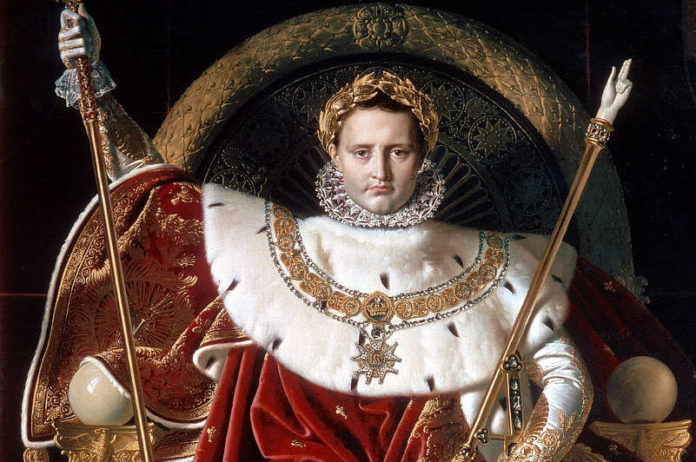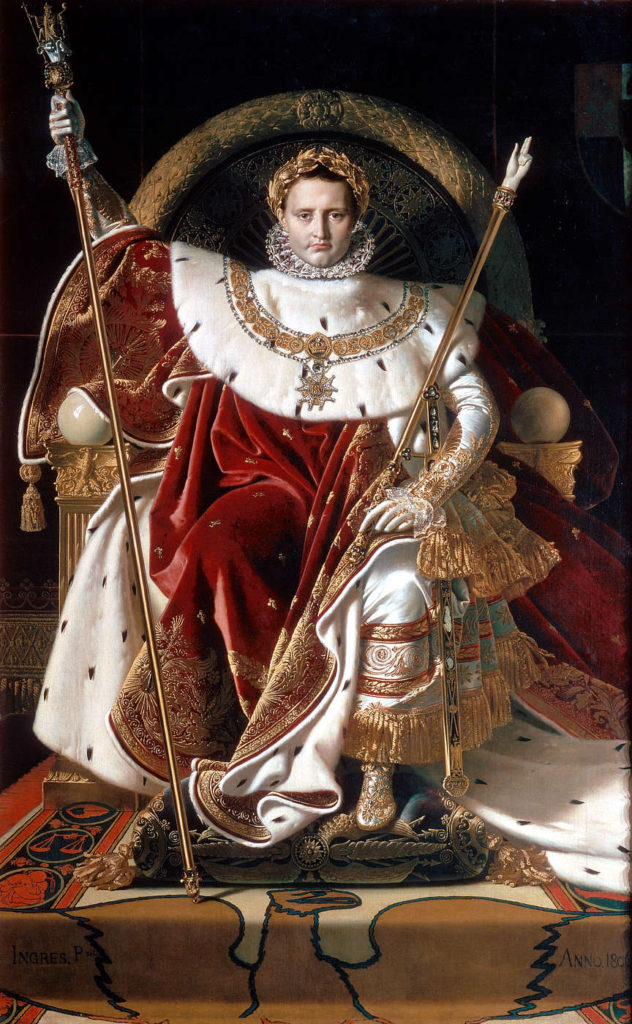
In this occasional series, Fine Art Today delves into the world of portraiture, highlighting historical and contemporary examples of superb quality and skill. This week we look at one of history’s most ambitious and stunning royal portraits.
Politics and art. Few world leaders have better understood the efficacy of art as public propaganda than Napoleon Bonaparte — and one of his portraitists, Jean-Auguste-Dominique Ingres, was perfectly suited and talented for the task. Circa 1806, Ingres executed one of history’s best-known examples of art as propaganda: a monumental portrait of Napoleon on his Imperial Throne — a picture in which every conceivable detail, from the Emperor’s defiant expression down to each golden thread in his infinitely elaborate regalia, is captured with unrivaled skill, intimacy, and care. In fact, the portrait is executed in such a way that it not only makes clear Napoleon’s power as ruler of the French, but verges on portraying the emperor as a divine ruler, if not God the Father himself.
Sound a bit too far? If your answer was yes, Napoleon finds himself smiling in his grave today because he knows Ingres did his job — and did it well. Historians agree that Ingres modeled his enthroned portrait after Jan van Eyck’s masterful imaging of God the Father found in the center panel of the Ghent Altarpiece, a painting which was at the time housed in the Musée Napoléon (now the Louvre Museum). However, as our readers can imagine, the overall enthroned composition is only a small, overarching message that is continually reinforced and expanded through the picture’s detailed features.

A quick glance around the portrait reveals several spread-winged imperial eagles, the largest of which is presented directly in the foreground, embroidered on the rug. The same eagle is repeated in the capitals of the armrests, which support massive ivory spheres. Also found in the rug are the scales of justice, a common governmental symbol. Cleverly placed in the darkness just above Napoleon’s left shoulder is a partially visible heraldic shield — a marker of Italy and the Papal States, tying the emperor to the Holy Catholic Church and proclaiming him King of Italy, which — of course — he was, as of 1805. All this before the sitter himself is considered.
Among the most recognizable accouterments on the emperor himself is the golden wreath that crowns his head — a symbol of kingship and victory that is traced to Classical Roman emperors. Napoleon holds not one, but two scepters. The scepter to the viewer’s right is topped by the hand of justice, while to the left is the staff that belonged to the 9th-century Holy Roman Emperor Charlemagne. Finally, an extravagant medal from the Légion d’honeur hangs from the sitter’s shoulders by an intricate, jewel-encrusted gold chain.
While the scope of this brief article cannot begin to deconstruct every detail and element of this massive and deeply complex portrait (about 8 1/2 feet tall and 5 1/3 feet wide), what we’ve detailed here highlights how adroit portraitists can employ hundreds of strategies, symbols, composition, and iconography to create a visual identity that communicates several different messages. Indeed, there can be no doubt that the neoclassical Ingres was one of history’s best, and his portrait of Napoleon on his imperial throne ranks among the most masterful portraits ever painted.
To learn more, visit the Musée de l’Armée, Paris.
This article was featured in Fine Art Today, a weekly e-newsletter from Fine Art Connoisseur magazine. To start receiving Fine Art Today for free, click here.







